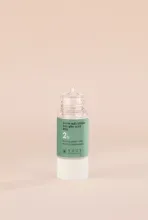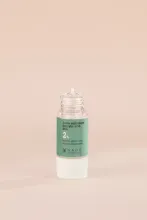Are you tired of those little pimples and blackheads settled on your face? Salicylic acid is the active ingredient recommended by dermatologists to regain a clear and pure skin. How does it work?
To reduce or even eliminate acne in teenagers and adults, cream formulations are sometimes as complex as they are mysterious. However, sometimes all it takes is a single active ingredient in the right dosage to make a difference! Salicylic acid is a BHA (beta-hydroxy acid), mainly used today for its exfoliating action. Its power? To eliminate the cells of the skin’s corneal layer, and to support their renewal. Tightened pores and flawless skin texture, here we are ready to face the test of the mirror!
<h2>Salicylic acid's origin</h2>
Salicylic acid is an organic compound that is a member of the BHA family of beta-hydroxy acids. Notably present in willow bark, it is however found in many other plants, such as fruits or meadowsweet. However, it was extracted from willow for the first time in 1853 by the chemist C. F. Gerhard, then by Felix Hoffmann in 1897, this time in the form of a pure extract.
Its medicinal properties have been known for a long time, especially in the treatment of fever and pain. Although it is nowadays dethroned by aspirin (a derivative of salicylic acid) or by paracetamol, it is still used in cosmetic preparations.
Nowadays, it is indeed its antiseptic and exfoliating properties that interest skin specialists. In short, it offers excellent natural exfoliation, especially for oily and mixed skin, which explains its presence in many formulas of creams for acne and blackheads.
How does salicylic acid help us achieve clear skin?
Salicylic acid is frequently used to treat acne or even hyperhidrosis, a condition that leads to excessive sweating. This active ingredient is equally effective against blackheads and skin imperfections due to an inflammatory phenomenon.
How does it work?
● It eliminates dead cells accumulated on the surface of the skin and stimulates their renewal.
● Through its exfoliating action, it reduces imperfections and refines the skin texture ;
● It unclogs clogged pores and thus prevents the appearance of new blackheads and microcysts.
Salicylic acid is recommended for teenagers in the grip of juvenile acne, but also as part of a treatment for adult acne.
How to use salicylic acid as an SOS treatment
When formulated with an optimal concentration of active ingredient (2%, the maximum dose allowed in cosmetics), salicylic acid is an excellent SOS treatment to remedy pimples and blackheads on the face.
Making sure to avoid the eye contour area, a salicylic acid-based treatment can be applied directly to the areas affected by imperfections. Wait until it is completely absorbed into the skin for it to take effect and avoid combining it with other acids such as citric acid or glycolic acid.
The duration of the treatment is variable, and the treatment can be used until there is a visible improvement in the condition of the skin.
How does salicylic acid help us achieve clear skin?
Salicylic acid is frequently used to treat acne or even hyperhidrosis, a condition that leads to excessive sweating. This active ingredient is equally effective against blackheads and skin imperfections due to an inflammatory phenomenon.
How does it work?
● It eliminates dead cells accumulated on the surface of the skin and stimulates their renewal.
● Through its exfoliating action, it reduces imperfections and refines the skin texture ;
● It unclogs clogged pores and thus prevents the appearance of new blackheads and microcysts.
Salicylic acid is recommended for teenagers in the grip of juvenile acne, but also as part of a treatment for adult acne.
How to use salicylic acid as an SOS treatment
When formulated with an optimal concentration of active ingredient (2%, the maximum dose allowed in cosmetics), salicylic acid is an excellent SOS treatment to remedy pimples and blackheads on the face.
Making sure to avoid the eye contour area, a salicylic acid-based treatment can be applied directly to the areas affected by imperfections. Wait until it is completely absorbed into the skin for it to take effect and avoid combining it with other acids such as citric acid or glycolic acid.
The duration of the treatment is variable, and the treatment can be used until there is a visible improvement in the condition of the skin.

